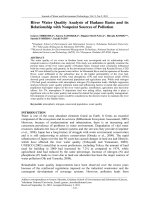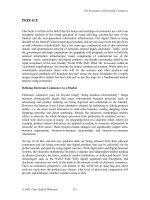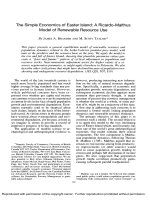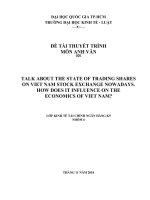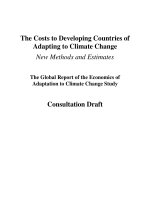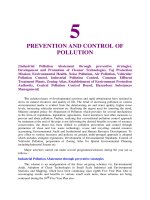Economics of pollution
Bạn đang xem bản rút gọn của tài liệu. Xem và tải ngay bản đầy đủ của tài liệu tại đây (952.65 KB, 125 trang )
2. Economics of pollution
2.3. How to meet optimal pollution
- The Coase Theorem
Property rights?
Property right of Environment?
Suppose that we have two groups: Polluters and
Receptors
Governmental decision/regulation:
• Not any pollutants can be emitted into
environment
• All kinds and amounts of pollutants may be
emitted into environment.
What defines property rights?
Property rights are established by formal and informal rules about the
privileges and limitations on the ownership, use, and transfer of goods and
resources. These rights are specified in various municipal ordinances,
other legislation, court decisions (common law), tradition and custom.
Property rights need to be:
1) clearly defined
2) exclusive
3) enforceable
4) transferable
Coase Theorem
• Insight: root of the inefficiencies from externalities
is the absence of property rights.
• The Coase Theorem states that once property rights
are established and transaction costs are small,
then one of the parties will bribe the other to attain
the socially efficient quantity.
• The socially efficient quantity is attained regardless
of whom the property rights were initially assigned.
4
Illustration of the Coase Theorem
• Recall the steel firm / fishery example. If the steel
firm was assigned property rights, it would initially
produce Q1, which maximizes its profits.
• If the fishery was assigned property rights, it would
initially mandate zero production, which minimizes
its damages.
5
Figure 5.3
Coase Theorem – assign property
rights to steel firm
• Consider the effects of the steel firm reducing production in
the direction of the socially efficient level, Q*. This entails a
cost to the steel firm and a benefit to the fishery:
– The steel firm (and its customers) would lose surplus between
the MB and MPC curves between Q1 and Q1-1, while the
fishery’s damages are reduced by the area under the MD curve
between Q1 and Q1-1.
– Note that the marginal loss in profits is extremely small,
because the steel firm was profit maximizing, while the
reduction in damages to the fishery is substantial.
– A bribe from the fishery to the steel firm could therefore make
all parties better off.
7
Coase Theorem – assign property
rights to steel firm
• When would the process of bribes (and pollution reduction)
stop?
– When the parties no longer find it beneficial to bribe.
– The fishery will not offer a bribe larger than it’s MD for a given
quantity, and the steel firm will not accept a bribe smaller than
its loss in profits (MB-MPC) for a given quantity.
– Thus, the quantity where MD=(MB-MPC) will be where the
parties stop bribing and reducing output.
– Rearranging, MC+MPC=MB, or MSC=MB, which is equal at Q *,
the socially efficient level.
8
Coase Theorem – assign property
rights to fishery
• Similar reasoning follows when the fishery has property
rights, and initially allows zero production.
– The fishery’s damages are increased by the area under the MD
curve by moving from 0 to 1. On the other hand, the steel
firm’s surplus is increased.
– The increase in damages to the fishery is initially very small,
while the gain in surplus to the steel firm is large.
– A bribe from the steel firm to the fishery could therefore make
all parties better off.
9
Coase Theorem – assign property
rights to fishery
• When would the process of bribes now stop?
– Again, when the parties no longer find it beneficial to
bribe.
– The fishery will not accept a bribe smaller than it’s MD for
a given quantity, and the steel firm will not offer a bribe
larger than its gain in profits (MB-MPC) for a given
quantity.
– Again, the quantity where MD=(MB-MPC) will be where
the parties stop bribing and reducing output. This still
occurs at Q*.
10
When is the Coase Theorem relevant or
not?
• Low transaction costs
– Few parties involved
• Source of externality well
defined
• Example: Several firms
with pollution
• Not relevant with high
transaction costs or illdefined externality
• Example: Air pollution
11
Coase Theorem
Building the graph
Producer creates
⇑ output
Creates benefits
“marginal”
benefits
(diminishing)
⇑ pollution
Building the graph
Producer creates
⇑ output
Creates benefits
“marginal”
benefits
(diminishing)
⇑ pollution
Total Benefit
to Company
Building the graph, cont’d
With
⇑ pollution
Community
experiences
⇑ Costs
clean up
health care
lost tourism
Total Costs to
Community
“Optimal” solution (max social benefit)
without actual transactions ??
Total Benefit to
Company
Total Costs to
Community
“Optimal” solution (max social benefit)
without actual transactions ??
@ 100 units pollution
⇓ output/pollution
⇓ benefits ‹
⇓ Costs to
community
Net Social Gain
“optimal” @ output
producing 60 units
of pollution
MBcompany = MCcommunity
“Optimal” amount
of pollution
“Equitable” to
Coase Theorem says same “optimal” outcome
obtained via market transactions
Case 1
Community owns
“right” to
determine
how much
pollution is
permissible
Begin with zero
pollution
Company would
like to
produce
output & gain
benefit.
But, creates
Pollution
Both parties benefit,
thus, both agree
“optimal”
60 reached
via Market
mechanism
Community has
1. pollution
costing
$6000 (C)
2.
3.
What has been achieved?
$12000
new income
(B+C)
Same “Optimal”
result obtained
via Market
Net Gain
$6000
Company has
1.
Made pmts
of $12000
(B+C)
2.
Gained
benefits of
$21000
(A+B+C)
3.
Net profit
of $9000
(A)
A = $9000
B = $6000
C = $6000
Case 2
Company owns “right” to determine how much
pollution they make
Begin with
output that
creates
maximum
benefits of
$25,000
(A+B+C+D)
and creating
100 units
pollution
Community
incurring
costs of
$17,000
(C+D+E+F)
A = $9000
F=$3000
E = $4000
B = $6000
C = $6000
D=$4000
Case 2 Company owns “right”,
Community
wants to
reduce
pollution
Offers to
make pmt
of $200
unit to
cutback
output
Cont’d
Both parties benefit,
thus, both agree
Community has
1. Eliminated
$11,000
in pollution
costs
(D+E+F)
2. Made pmts
of $8,000
(D+E)
3. Left with
pollution
costs of
$6,000
4. Total
Outlay (to
What has been achieved? For
community
F=$3000
get rid of
all pollution)
E = $4000
$14,000
(C+D+E)
vs,$17,000
C = $6000
D=$4000
Company has
1.
Reduced
output &
pollution,
giving up
benefit of
$4,000 (D)
2.
Received pmts
of $8,000
(D+E)
3.
Retains
existing
benefit of
$21,000
(A+B+C)
4.
Existing
benefit plus
pmts = Total
Benefit
$29,000
(A+B+C+D+E)
What has been achieved? For
the company
A = $9000
F=$3000
E = $4000
B = $6000
C = $6000
D=$4000
Company Holds Rights
Community
Beginning
position
$17,000 Pollution costs
8,000 Pmts made
11,000 ⇓ Pollution
costs
6,000 Remain Costs
Ending position
$14,000 Total pmts made
& remain costs
$3,000 Improvement
Change in
Pollution
40 unit Reduction
Company
Text
p53
$25,000 Benefits
$8,000 Pmts rec’d
4,000 ⇓ Lost benefits
from ⇓ output &
pollution
21,000 Remain benefits
$29,000 Total pmts rec’d &
remain benefit
$4,000 Improvement
(60 units remain)
Community Holds Rights
Community
Begin
position
0 units Pollution
$12,000 Pmt rec’d
6,000 Pollution
permitted
Company
$0 Benefits
$12,000 Pmt made
21,000 Benefit from
new output &
pollution
End position
$6,000 Remain after
$9,000 Remain benefit
after pmts
Improvement
$6,000
$9,000
Change in
pollution
pmts used to
clean up
pollution
0 units
(60 units created, but cleaned up)
